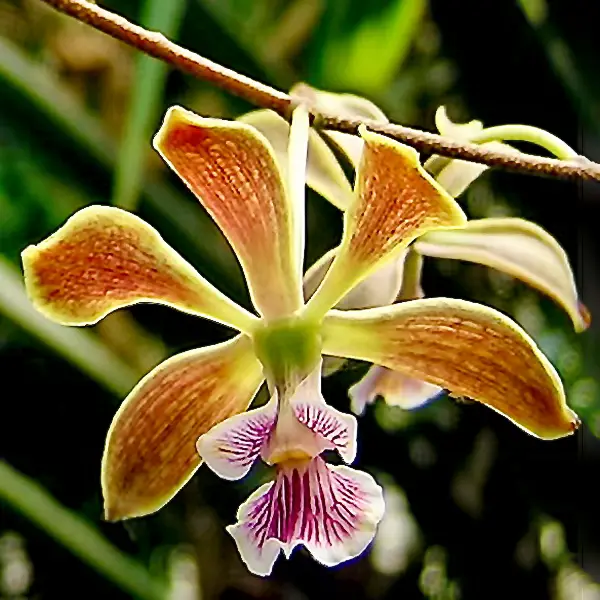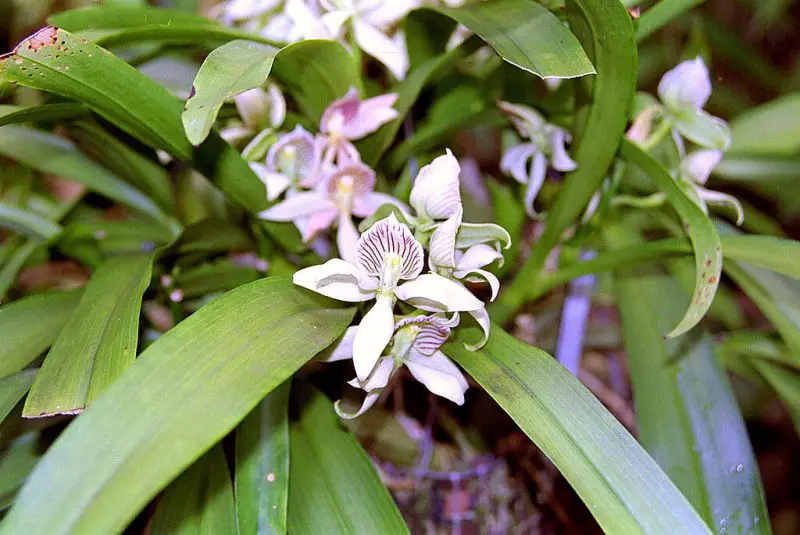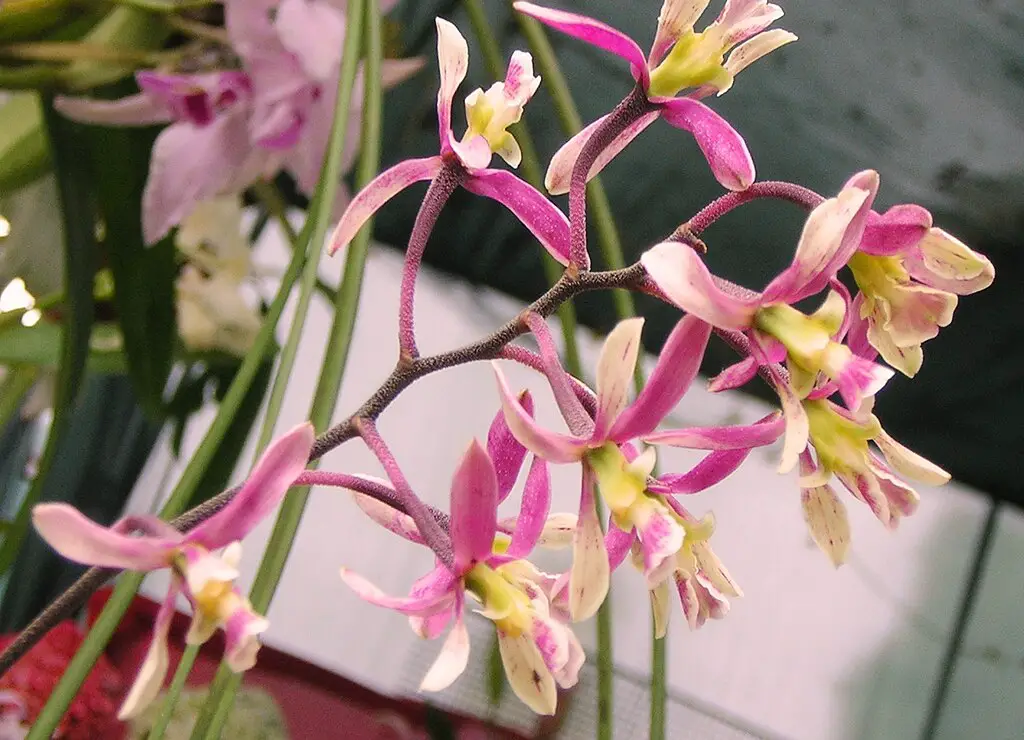
Discover the essentials of Encyclia Orchid Care with our guide. Learn how to nurture these captivating plants for vibrant blooms and healthy growth.
Encyclia Orchid Care Key Takeaways:
- Encyclia Orchid Care involves providing bright, indirect light,
- Maintaining warm to intermediate temperatures of 70°F to 85°, and ensuring moderate humidity of 40% to 60%.
- Water when the potting mix begins to dry out and fertilize regularly during the growing season.
- Repot every two to three years and monitor for pests and diseases.
- With proper care, these captivating orchids will reward you with stunning blooms.
Welcome to the world of Encyclia Orchid Care! These enchanting orchids, known for their diverse beauty and unique blooms, require a special touch to thrive.
Dive into our friendly guide as we explore the key care tips to keep your Encyclia orchids flourishing and adding a touch of elegance to your indoor garden.
Introduction to Encyclia Orchid Care
Encyclia orchids, also known as butterfly orchids, are a diverse group of epiphytic plants that are popular among orchid enthusiasts.
These orchids are known for their unique lip structure and a wide range of sizes and colors.
In this guide, we’ll explore the essentials of Encyclia orchid care, helping you to grow and maintain these beautiful plants successfully.
Overview of Encyclia Orchids
Encyclia orchids belong to a large and varied genus, with species ranging from small plants with 2-inch pseudobulbs to larger varieties with leaves over 2 feet long.
Despite their diversity, all Encyclia orchids share a common feature: a lip that, while not fused to the column, more or less enfolds it.
This unique characteristic, along with their striking blooms, makes them a favorite among orchid collectors.
Encyclia is a genus of orchids. The genus name comes from Greek enkykleomai (to encircle), referring to the lateral lobes of the lip which encircle the column. It is abbreviated as E. in the horticultural trade. Wikipedia
Importance of Proper Care
Proper care is crucial for the healthy growth and blooming of Encyclia orchids.
These plants thrive in specific environmental conditions, including the right balance of light, temperature, humidity, and watering.
Understanding and providing these requirements will ensure that your Encyclia orchids flourish, rewarding you with their stunning flowers year after year.
In the following sections, we will delve into the specific care requirements for Encyclia orchids, covering everything from light and temperature to watering and potting.
Whether you’re a seasoned orchid grower or new to the world of Encyclia, this guide will provide you with the knowledge you need to care for these captivating plants.
Understanding Encyclia Orchids

Encyclia orchids are a fascinating group of plants that are cherished by orchid enthusiasts for their diversity and unique beauty.
In this section, we’ll explore the origin and distribution of Encyclia orchids, highlight some common species and their characteristics, and delve into the unique features that set these orchids apart.
Origin and Distribution
Encyclia orchids are native to the Americas, with a range that extends from Florida and the Caribbean through Mexico, Central America, and South America, all the way to Argentina.
This wide distribution reflects the adaptability of the genus to various habitats, from tropical rainforests to arid regions.
The genus Encyclia was established in 1828, and since then, it has been subject to various classifications, with the number of species continually evolving.
Common Species and Their Characteristics
Among the numerous species of Encyclia orchids, some of the most commonly grown include:
- Encyclia cordigera: Known for its large, fragrant flowers that come in shades of brown, green, and purple.
- Encyclia cochleata (now classified as Prosthechea cochleata): Also known as the cockleshell orchid, it features distinctive flowers with a unique lip shape.
- Encyclia tampense: Native to Florida, this species is admired for its star-shaped flowers with a delicate fragrance.
- Encyclia alata: Recognized by its yellow and brown flowers, this species is often called the butterfly orchid due to the shape of its blooms.
Each species has its own unique set of characteristics, including flower size, color, and fragrance, as well as growth habits and cultural requirements.
Unique Features of Encyclia Orchids
One of the defining features of Encyclia orchids is the lip of the flower, which is not fused to the column and often enfolds it.
This distinctive trait is where the genus gets its name, derived from the Greek word enkyklein, meaning to encircle.
Additionally, Encyclia orchids exhibit a wide range of variability in size, from compact plants with small pseudobulbs to larger specimens with extensive foliage.
This diversity, along with their often vibrant and uniquely shaped flowers, makes Encyclia orchids a captivating group within the orchid family.
In the next sections, we’ll delve into the specific care requirements for Encyclia orchids, covering everything from light and temperature to watering and potting, to help you successfully grow these remarkable plants
Light Requirements for Encyclia Orchids
Proper lighting is crucial for the growth and blooming of Encyclia orchids.
In this section, we’ll explore the ideal light conditions for these orchids and provide tips for ensuring they receive adequate light, especially when grown indoors.
Ideal Light Conditions
Encyclia orchids thrive in bright, indirect light. They prefer a light intensity similar to that enjoyed by Cattleya orchids, which is typically around 2,000 to 3,000 foot-candles.
However, they should be protected from direct midday sun, which can scorch their leaves.
An east-facing window that provides morning sunlight or a shaded south-facing window is ideal for these orchids.
Tips for Providing Adequate Light Indoors
- Use Sheer Curtains: If you’re growing Encyclia orchids near a window that receives direct sunlight, consider using sheer curtains to diffuse the light and prevent leaf burn.
- Artificial Lighting: In areas with insufficient natural light, artificial lighting such as fluorescent or LED grow lights can be used. Place the lights about 12-18 inches above the orchids and provide 12-14 hours of light per day.
- Rotate Plants: Regularly rotating your orchids can ensure that all sides of the plant receive equal light exposure, promoting balanced growth.
- Monitor Leaf Color: The color of the leaves can be an indicator of light levels. Ideally, Encyclia orchid leaves should be a bright, grassy green. If the leaves are dark green, the plant may need more light. Conversely, if the leaves are yellowish or reddish, the plant may be receiving too much light.
By providing the right amount of light, you can encourage healthy growth and vibrant blooms in your Encyclia orchids.
Always observe your plants and adjust their light exposure as needed to ensure their well-being.
Temperature and Humidity for Encyclia Orchids
Temperature and humidity play a significant role in the health and growth of Encyclia orchids.
In this section, we’ll discuss the optimal temperature range for these orchids and the importance of maintaining the right humidity levels.
Optimal Temperature Range
Encyclia orchids generally prefer warm to intermediate temperatures.
The ideal daytime temperature range is between 70°F to 85°F (21°C to 29°C), while nighttime temperatures should be between 55°F to 65°F (13°C to 18°C).
Some species may tolerate slightly cooler or warmer conditions, but extreme temperatures should be avoided to prevent stress and damage to the plants.
Importance of Humidity
Humidity is crucial for Encyclia orchids, as they are epiphytic plants that naturally absorb moisture from the air.
A humidity level of 40% to 60% is ideal for most Encyclia species. Proper humidity levels help prevent dehydration, support healthy growth, and encourage flowering.
Ways to Maintain Humidity
- Humidifiers: Using a humidifier near your orchids can help maintain consistent humidity levels, especially during dry seasons or in air-conditioned environments.
- Trays with Water and Pebbles: Place a tray filled with water and pebbles beneath your orchid pots. As the water evaporates, it increases the humidity around the plants. Ensure the pots are not sitting directly in the water to avoid root rot.
- Grouping Plants: Placing orchids close together can create a microclimate with higher humidity levels, as the plants naturally release moisture into the air.
- Misting: Lightly misting the orchids and surrounding air in the morning can provide a temporary humidity boost. Avoid misting in the evening to prevent water from sitting on the leaves overnight, which can lead to fungal issues.
By monitoring and adjusting the temperature and humidity levels, you can create an optimal environment for your Encyclia orchids to thrive.
Always observe your plants for signs of stress and make necessary adjustments to their environment to ensure their well-being.
Watering and Feeding Encyclia Orchids

Proper watering and feeding are essential for the health and blooming of Encyclia orchids.
In this section, we’ll provide guidelines for watering these orchids and discuss their fertilizer requirements and feeding schedule.
Guidelines for Watering
- Check Moisture Level: Before watering, check the moisture level of the potting mix by feeling it with your fingers. Encyclia orchids prefer to dry out slightly between waterings, so the mix should be just slightly moist.
- Water Thoroughly: When it’s time to water, do so thoroughly, allowing water to run through the potting mix and out of the drainage holes. This ensures that the roots are adequately hydrated.
- Avoid Overwatering: Overwatering can lead to root rot, which is a common problem with orchids. Ensure good drainage and avoid letting the orchids sit in standing water.
- Adjust Watering Frequency: The frequency of watering will depend on factors such as the potting medium, humidity, temperature, and the orchid’s growth phase. Generally, watering once a week is a good starting point, but adjust as needed based on the plant’s environment and needs.
Fertilizer Requirements and Feeding Schedule
- Balanced Fertilizer: Encyclia orchids benefit from a balanced fertilizer, such as a 20-20-20 formula, which provides an equal ratio of nitrogen, phosphorus, and potassium.
- Feeding Schedule: During the active growing season (spring and summer), fertilize every two weeks. In the dormant season (fall and winter), reduce fertilization to once a month.
- Dilute Concentration: It’s important to dilute the fertilizer to about half the strength recommended on the package to avoid fertilizer burn.
- Flush with Water: Occasionally, flush the potting mix with plain water to remove any accumulated salts from the fertilizer.
By following these watering and feeding guidelines, you can ensure that your Encyclia orchids receive the right amount of moisture and nutrients to support their growth and flowering.
Always observe your orchids and adjust their care as needed to keep them healthy and thriving.
Potting and Repotting Encyclia Orchids
Proper potting and timely repotting are crucial for the health of Encyclia orchids.
In this section, we’ll discuss suitable potting mixes and pot types, signs that indicate it’s time to repot, and a step-by-step guide to the repotting process.
Suitable Potting Mix and Pot Types
- Potting Mix: Encyclia orchids prefer a well-draining potting mix that allows air to reach their roots. A mix of medium-grade bark, perlite, and charcoal is commonly used. Some growers also incorporate sphagnum moss for added moisture retention.
- Pot Types: Clay pots are ideal for Encyclia orchids as they allow the potting mix to dry out more evenly and provide good air circulation. Plastic pots can also be used, but they tend to retain moisture longer, so be cautious with watering.
Signs That Indicate It’s Time to Repot
- Overgrown Roots: When the orchid’s roots start to outgrow the pot or grow through the drainage holes, it’s time to repot.
- Degraded Potting Mix: If the potting mix has broken down and become compacted, it can impede drainage and air flow, necessitating repotting.
- Poor Growth or Health: If the orchid is not thriving and other care factors have been addressed, repotting into fresh mix might be needed.
Step-by-Step Repotting Process
- Prepare Materials: Gather a new pot, fresh potting mix, and sterilized pruning shears or scissors.
- Remove Orchid: Gently remove the orchid from its old pot, being careful not to damage the roots.
- Clean Roots: Remove any dead or rotting roots and old potting mix from the root ball. Use sterilized pruning shears to trim away any unhealthy roots.
- Select Pot: Choose a new pot that is slightly larger than the root ball. Ensure it has adequate drainage holes.
- Add Potting Mix: Place a layer of fresh potting mix at the bottom of the new pot.
- Position Orchid: Place the orchid in the pot and gently spread out the roots. Fill in around the roots with more potting mix, tapping the pot to settle the mix.
- Water and Care: Water the orchid lightly to settle the mix and place it in a location with appropriate light and temperature. Resume normal care, allowing the orchid to adjust to its new pot.
Repotting Encyclia orchids every two to three years, or as needed, helps ensure they have the right conditions to thrive.
Always use clean tools and pots to prevent the spread of disease, and be gentle with the orchid’s roots during the repotting process.
Common Pests and Diseases Affecting Encyclia Orchids
Encyclia orchids, like all plants, can be susceptible to pests and diseases.
In this section, we’ll cover the identification and prevention of common pests, as well as treatment options for diseases that may affect Encyclia orchids.
Identification and Prevention of Common Pests
- Spider Mites: These tiny pests can cause yellowing and speckling on leaves. Increase humidity and use a miticide if necessary.
- Scale Insects: These appear as small brown or white bumps on leaves and stems. Remove them manually or use insecticidal soap.
- Mealybugs: These white, cottony pests can be found in leaf axils and on roots. Use rubbing alcohol or insecticidal soap to remove them.
- Prevention: Regularly inspect your orchids for signs of pests. Maintain good air circulation, proper humidity, and cleanliness to prevent infestations.
Treatment Options for Diseases
- Root Rot: Caused by overwatering or poor drainage, root rot can be fatal if not addressed. Repot the orchid in fresh, well-draining medium and reduce watering.
- Leaf Spot: Fungal or bacterial infections can cause spots on leaves. Remove affected leaves and apply a fungicide or bactericide as needed.
- Viruses: Symptoms include color streaking and distorted growth. There is no cure for viral infections; affected plants should be isolated and destroyed to prevent spread.
By regularly monitoring your Encyclia orchids for signs of pests and diseases, you can take early action to prevent serious problems.
Always use clean tools and pots when handling your orchids, and quarantine new plants before introducing them to your collection.
Blooming and Flower Care for Encyclia Orchids
The blooming of Encyclia orchids is a highlight for any orchid enthusiast.
In this section, we’ll explore the factors that influence blooming and provide tips for prolonging the life of Encyclia flowers.
Factors That Influence Blooming
- Light: Adequate light is crucial for flower development. Encyclia orchids need bright, indirect light to initiate blooming.
- Temperature: A drop in temperature, especially at night, can trigger blooming in many Encyclia species. Aim for a 10-15°F difference between day and night temperatures.
- Watering: While Encyclia orchids should dry out slightly between waterings, consistent moisture is important during the growth and blooming phases.
- Fertilization: Regular feeding with a balanced fertilizer during the growing season supports healthy growth and flower production.
Tips for Prolonging the Life of Encyclia Flowers
- Maintain Humidity: Keep the humidity level around 40-60% to prevent the flowers from drying out too quickly.
- Avoid Direct Sunlight: While Encyclia orchids need bright light, direct sunlight can cause the flowers to fade or burn. Provide filtered or indirect light.
- Optimal Temperature: Keep the orchids in their preferred temperature range, avoiding sudden temperature fluctuations that can shorten flower lifespan.
- Remove Spent Flowers: Regularly remove spent flowers to encourage the plant to focus its energy on remaining blooms and new growth.
By understanding the factors that influence blooming and following these tips for flower care, you can enjoy the beautiful blooms of your Encyclia orchids for a longer period.
Always observe your plants and adjust their care as needed to support their flowering and overall health.
Propagation of Encyclia Orchids
Propagation is a rewarding way to increase your collection of Encyclia orchids.
In this section, we’ll discuss the methods for propagating these orchids and provide tips for successful propagation.
Methods for Propagating
- Division: This is the most common method for propagating Encyclia orchids. When repotting, you can divide the orchid into smaller clumps, each with at least three pseudobulbs. Plant each division in its own pot with suitable potting mix.
- Keiki Growth: Occasionally, Encyclia orchids may produce keikis (baby plants) on their flower spikes. Once the keiki has developed roots, it can be carefully removed and potted separately.
- Back Bulbs: Older pseudobulbs that have lost their leaves, known as back bulbs, can sometimes be encouraged to produce new growth. Plant them in a moist potting mix, and with proper care, they may develop into new plants.
Tips for Successful Propagation
- Use Sterile Tools: Always use sterilized tools when cutting or dividing orchids to prevent the spread of disease.
- Provide Optimal Conditions: After propagation, ensure that the new plants are placed in conditions suitable for their growth, with appropriate light, temperature, and humidity.
- Patience: Propagation can be a slow process, especially when waiting for back bulbs or keikis to develop. Be patient and provide consistent care.
- Monitor Health: Keep an eye on the newly propagated plants for signs of stress or disease, and adjust care as needed to ensure their healthy growth.
Propagation not only helps expand your orchid collection but also rejuvenates older plants by dividing and repotting them.
With patience and proper care, you can successfully propagate your Encyclia orchids and enjoy the rewards of your efforts.
FAQs: Encyclia Orchid Care
Encyclia orchids are cherished for their diverse beauty and unique characteristics.
As with any orchid, questions often arise about their care and maintenance.
Here, we address some of the most common questions about Encyclia orchid care, providing insights and tips to help you successfully grow these captivating plants.
Q: How often should I water my Encyclia orchid?
A: Encyclia orchids should be watered when the potting mix begins to dry out.
This typically means watering once a week, but the frequency may vary depending on factors such as temperature, humidity, and the type of potting mix used.
Q: What is the best temperature range for Encyclia orchids?
A: Encyclia orchids prefer warm to intermediate temperatures, with daytime temperatures between 70°F to 85°F (21°C to 29°C) and nighttime temperatures between 55°F to 65°F (13°C to 18°C).
Q: How much light do Encyclia orchids need?
A: Encyclia orchids thrive in bright, indirect light. They should be protected from direct midday sun to prevent leaf burn.
An east-facing window or a shaded south-facing window is ideal.
Q: How do I fertilize my Encyclia orchid?
A: Use a balanced orchid fertilizer (such as a 20-20-20 formula) diluted to half strength.
Fertilize every two weeks during the active growing season (spring and summer) and reduce to once a month during the dormant season (fall and winter).
Q: How long do Encyclia flowers last?
A: Encyclia orchid flowers can last for several weeks to a few months, depending on the species and environmental conditions.
Q: What type of orchid is an Encyclia?
A: Encyclia is a genus of epiphytic orchids, known for their unique lip structure and diverse range of sizes and colors.
Q: When should I repot my Encyclia orchid?
A: Repot your Encyclia orchid every two to three years or when the potting mix breaks down and becomes compacted. Signs that it’s time to repot include overgrown roots and poor growth.
Q: Can Encyclia orchids be grown indoors?
A: Yes, Encyclia orchids can be successfully grown indoors as long as they receive adequate light, humidity, and proper care.
Conclusion: Embracing Encyclia Orchid Care
In conclusion, Encyclia orchids are a captivating group of plants that offer a diverse range of colors, sizes, and shapes.
By following the key care tips outlined in this guide, you can ensure the health and vitality of your Encyclia orchids:
- Provide bright, indirect light to encourage healthy growth and blooming.
- Maintain warm to intermediate temperatures and moderate humidity levels.
- Water when the potting mix begins to dry out, and fertilize regularly during the growing season.
- Repot every two to three years or when the potting mix breaks down.
- Monitor for pests and diseases, and take action promptly if any issues arise.
Encyclia orchids are not only beautiful but also rewarding to grow.
With their unique features and stunning flowers, they are sure to add elegance and charm to any orchid collection.
So, embrace the beauty of Encyclia orchids, and enjoy the journey of nurturing these exquisite plants to their full potential.
Learn more about different orchid types
Read more: Are Orchids Hard To Take Care Of? Easy Growth Formula
Resources: Further Reading for Encyclia Orchids
For more information on Encyclia orchids and their care, the following reputable sources can be helpful:
- American Orchid Society (AOS): A comprehensive resource for orchid care, including cultural sheets and articles on Encyclia orchids. Visit AOS
- Orchid Species: Provides detailed information on various orchid species, including Encyclia. Visit Orchid Species
- Orchid Care Tips: A blog dedicated to orchid care, offering tips and advice for growing healthy orchids, including Encyclia species. Visit Orchid Care Tips
- Missouri Botanical Garden: Offers a plant finder tool and care information for a variety of plants, including orchids. Visit Missouri Botanical Garden
- Royal Horticultural Society (RHS): Provides a wealth of information on orchid care and cultivation. Visit RHS
These resources can provide valuable insights and guidance for both novice and experienced orchid enthusiasts looking to learn more about Encyclia orchids and their care.
This post contains affiliate links.

